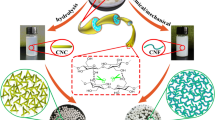Abstract
Recently-discovered lignocellulosic solvent, 8%(w/w) lithium chloride/dimethyl sulfoxide (LiCl/DMSO), was found to dissolve cellulose of varied crystal forms and degree of polymerization. Cellulose samples could be activated for dissolution by complexation with ethylenediamine (EDA), giving EDA contents of 20–23% (w/w) in the complex irrespective of the cellulose type. The cellulose solution gave well-resolved 13C NMR spectrum, confirming molecular dispersion. Cellulose could be coagulated by ethanol to give translucent cellulose gels, which could be converted to highly porous aerogels via solvent exchange drying. Nitrogen adsorption analysis gave their specific surface areas of 190–213 m2/g, with typical mesopore sizes of 10–60 nm. Scanning electron microscopy revealed the network structure of aerogel composed of relatively straight fibril segments, approx. 20 nm wide and 100–1,000 nm long. X-ray diffraction showed that the material is poorly crystalline cellulose II.








Similar content being viewed by others
References
Blachot JF, Dupeyre D, Verdier C (2001) Peelback of highly oriented cellulosic fibres. J Mater Sci 36:4223–4230
Cai J, Kimura S, Wada M, Kuga S, Zhang L (2008) Cellulose aerogels from aqueous alkali hydroxide–urea solution. Chem Sus Chem 1:149–154
Cheng Q, Wang S, Rials TG, Lee SH (2007) Physical and mechanical properties of polyvinyl alcohol and polypropylene composite materials reinforced with fibril aggregates isolated from regenerated cellulose fibers. Cellulose 14:593–602
Gavillon R, Budtova T (2007) Kinetics of cellulose regeneration from cellulose-NaOH-water gels and comparison with cellulose-NMMO-water solutions. Biomacromolecules 8:424–432
Gavillon R, Budtova T (2008) Aerocellulose: new highly porous cellulose prepared from cellulose-NaOH aqueous solutions. Biomacromolecules 9:269–277
Ishii D, Tatsumi D, Matsumoto T, Murata K, Hayashi H, Yoshitani H (2006) Investigation of the structure of cellulose in LiCl/DMAc solution and its gelation behavior by small-angle X-Ray scattering measurements. Macromol Biosci 6:293–300
Jin H, Nishiyama Y, Wada M, Kuga S (2004) Nanofibrillar cellulose aerogels. Coll Surf A Physicochem Eng Aspects 240:63–67
Karlsson JO, Gatenholm P (1997) Preparation and characterization of cellulose-supported HEMA hydrogels. Polymer 38:4727–4731
Kistler SS (1931) Coherent expanded aerogels and jellies. Nature 227:741
Kistler SS (1932) Coherent expanded-aerogels. J Physical Chem: 36:52–64
Kuga S (1980) The porous structure of cellulose gel regenerated from calcium thiocyanate solution. J Colloid Interface Sci 77:413–417
Loeb L, Segal L (1955) Studies of the ethylenediamine-cellulose complex. I. Decomposition of the complex by solvents. J Polymer Sci 15:343–354
Miyashita Y, Nishio Y, Kimura N, Suzuki H, Iwata M (1996) Transition behaviour of cellulose/poly(Nvinylpyrrolidone-co-glycidyl methacrylate) composites synthesized by a solution coagulation/bulk polymerization method. Polymer 37:1949–1957
Nishio Y, Hirose N (1992) Cellulose/poly (2-hydroxyethyl methacrylate) composites prepared via solution coagulation and subsequent bulk polymerization. Polymer 33:1519–1524
Wada M, Kwon GJ, Nishiyama Y (2008) Structure and thermal behavior of a cellulose I-ethylenediamine complex. Biomacromolecules 9:2898–2904
Wang Z, Yokoyama T, Chang HM, Matsumoto Y (2009) Dissolution of beech and spruce milled woods in LiCl/DMSO. J Agric Food Chem 57:6167–6170
Wang Z, Yokoyama T, Matsumoto Y (2010) Dissolution of ethylenediamine pretreated pulp with high lignin content in LiCl/DMSO without milling. J Wood Chem Technol 30:219–229
Yanagisawa M, Shibata I, Isogai A (2004) SEC–MALLS analysis of cellulose using LiCl/1, 3-dimethyl-2-imidazolidinone as an eluent. Cellulose 11:169–176
Acknowledgments
This research was supported by Grant-in-Aids for Scientific Research (Grant Nos. P09015) from the New Energy and Industrial Technology Development Organization (NEDO). As well as, the financial support of this study, 973 National Basic Research Program of China (No.2010CB732205), is gratefully acknowledged.
Author information
Authors and Affiliations
Corresponding author
Rights and permissions
About this article
Cite this article
Wang, Z., Liu, S., Matsumoto, Y. et al. Cellulose gel and aerogel from LiCl/DMSO solution. Cellulose 19, 393–399 (2012). https://doi.org/10.1007/s10570-012-9651-2
Received:
Accepted:
Published:
Issue Date:
DOI: https://doi.org/10.1007/s10570-012-9651-2




